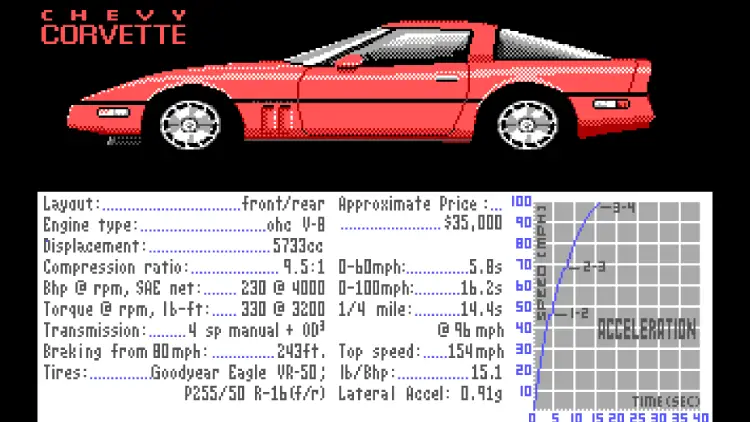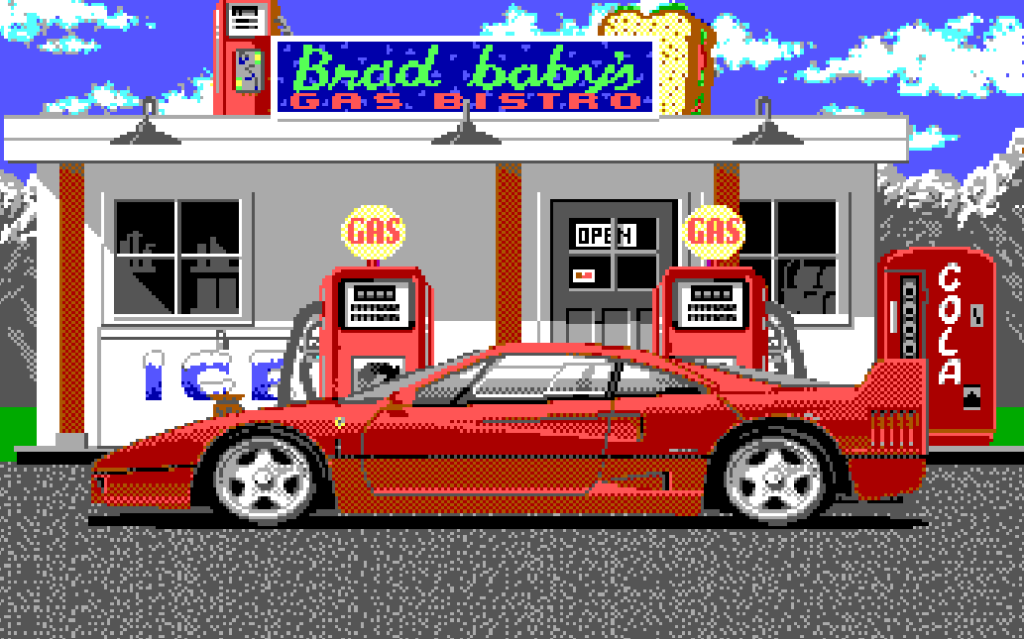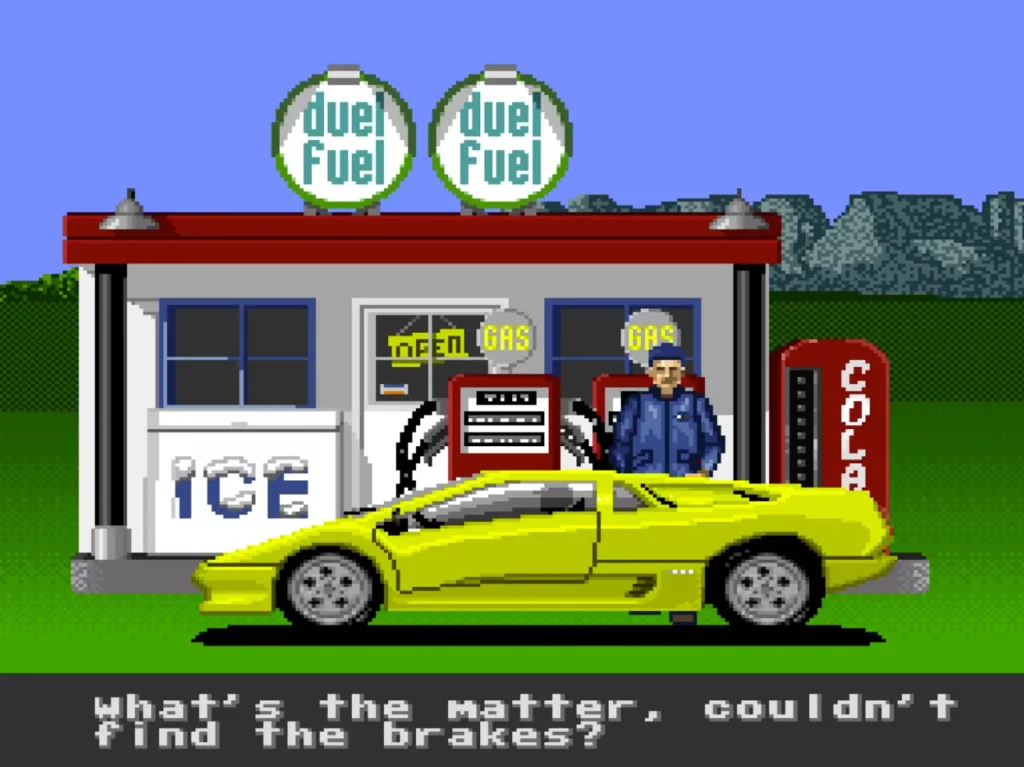The Duel: Test Drive II – A Controversial Sequel

I have no recollection of how I acquired The Duel: Test Drive II when I was a kid, but somehow the little blue floppy disk was in with the rest of our games when we moved into a new house. It became a staple of my early video game childhood, along with Sega’s Out Run in the arcade and Pole Position for the Atari 2600. It was the only racing game that I would own until I got Mega Race.
Developer Background: Distinctive Software
Canadian teenagers, Don Mattrick and Jeff Sembers, developed the game Evolution for the Apple II in 1981. Soon after, a demo of the game was picked up by the 10-year old son of Sydney Development Corporation (or SDC) founder Tarnie Williams. Seeing how much his son enjoyed the game, Williams offered to distribute the game for Mattrick and Sembers.
One of Canada’s first
So began one of Canada’s first software development studios. Mattrick and Sembers formalized the creation of their software company, called Distinctive Software, in 1982. Evolution would go on to sell over 400,000 copies and be the first hit video game developed in Canada.1

After their first title, Distinctive Software would focus on sports and simulation titles for the remainder of the decade, and partner with publisher Accolade to distribute many of their games.
Test Drive
After a string of hits for the Commodore 64, including Fight Night and Hardball!, the company created a driving simulation called Test Drive. The game would be distributed by Accolade and was a hit, selling over half a million units. One of the key differentiators for the game was the ability to drive one of five different sports cars – a Ferrari Testerossa, a Corvette C4, a Lotus Esprit, a Porsche 911 Turbo, or the iconic Lamborghini Countach. At the time, this was a big deal, as most games at the time stuck you with just one car.

The other feature of Test Drive was its realistic driving mechanics. Games up to that point had been “arcade” drivers, which didn’t drive anything like a real performance machine. Test Drive was geared toward the realism of driving these actual cars, with recreated interiors that matched the real thing as best as 1987 graphics could.
The Duel: Test Drive II Development
After the success of Test Drive, a sequel was scheduled. Partner Accolade would once again publish the game. But before the game was finished, Distinctive Software would port Sega’s smash hit, After Burner, to Amiga, Commodore 64 and PC-DOS systems. Up until this point, the company had been relying on Accolade for all distribution. Accolade would take exception to this later on.

The sequel to Test Drive aimed to build on the foundation of the original driving simulation but also offered improved visuals, more challenging game play, and more courses (the original’s major fault was having only one course).
The team focused on creating a game that was not only fun to play but also offered a better sense of realism that was rare for the time. Mattrick paid meticulous attention to the design of the cars, the behavior of the traffic, and the layout of the roads. The goal was to provide players with an immersive driving experience that felt authentic and exhilarating.
In making the game more immersive, the only camera angle is from within the cockpit of the car. There is no third person view in the game like in other racers such as Pole Position or OutRun.

One of the interesting aspects of the sequel’s development was the scaling back of the car lineup. The Duel: Test Drive II featured only two iconic sports cars: the Porsche 959 and the Ferrari F40 (a third, the Lamborghini Diablo, was only available on console versions in 1992). These vehicles were meticulously recreated in the game, with detailed graphics and realistic handling characteristics that reflected their real-life counterparts. However, scaling back the number of cars was the first thing players of the original would see. Want to drive the Corvette C4 from the original Test Drive? Too bad!
To somewhat make up for the lack of vehicle selections, this time around the team would create three courses, known as “scenes” – a desert, a mountain, and a grassy area, which were all played one after the other. On PC, the graphics were decent for the time, with the cutaway shot at each gas station being the one image in the game that made kids in 1989 go, “Whoa!”

The development team also added in levels of difficulty, with the first few levels of difficulty featuring an automatic transmission instead of the manual-only setup in the original Test Drive. This made the game more approachable to new drivers. The framerate of approaching cars was also increased a bit, giving drivers a bit more warning of oncoming hazards.
Gameplay Mechanics
The Duel: Test Drive II offered a unique blend of racing and simulation. Players could choose to race against the clock or “duel” head-to-head against another driver.
Like the first Test Drive, the goal for each course in the sequel was to reach the gas station as fast as possible without crashing or getting caught by the police.
The gameplay was split into different segments, each representing a different leg of the race. The segments each ended with a gas station that you had to stop at or you would later run out of gas and lose a life. Between these segments, players could view detailed statistics about their performance, including speed, time, and damage to their vehicle.
One of the standout features of The Duel: Test Drive II was the inclusion of police chases. If players exceeded the speed limit or drove recklessly, they could attract the attention of the police, resulting in high-speed chases that added excitement and tension to the game. Each car had a fuzz buster/radar detector in it that would tell you when police were nearby or on your tail, with it getting louder as the police closed in. When playing it now, this feels a lot like the star system later implemented in the Grand Theft Auto series.
On the PC version, if you make it to the end of the race, you are met with a surprise cinematic with a busty female police officer. Your character, unseen up until that point in the game, makes a flirty face with her, and in return, she flaps the cuffs on you and smiles back.
Graphics and Sound
For its time, The Duel: Test Drive II boasted impressive graphics. The interiors of each car were unique and represented their real-life counterparts fairly well. The environments are blocky, but look descent for the time period and add a level of depth and immersion as players sped through the various courses.

The sound design also played a crucial role in enhancing the gameplay experience. The PC-DOS version has very rudimentary sound effects and music. It’s a bit grating on the ears after a while.
However, the console versions were leaps and bounds better than the PC version. Featured roaring engines, real-life sirens, and the sound of cars whirring by you as you passed them at breakneck speeds, the console versions were just plain better. These sound effects, combined with the game’s dynamic music, helped to create an adrenaline-pumping atmosphere that kept players much more engaged than the PC version.
PC vs. Console Versions
The original PC version of The Duel was slightly better in graphics than its predecessor, with better draw-in and framerate. However, it still played choppy and the sound was not great. Those issues would get fixed in the console versions. As mentioned previously, the sounds of game are much better on both the Genesis and SNES ports. The console versions also feature more tracks and the addition of the Lamborghini Diablo.

The SNES version was the best of the bunch, and also scored much higher with critics than its PC counterpart. It has superior graphics to the PC and Genesis versions, as well as better sound and the ability for your car to go airborne over hills.
The limitations of PC gaming at the time were probably to blame for this. Because the game had to be compatible with nearly any PC, it had to be tailored to the lowest common denominator. The PC version of the game is known to run on just about anything, whereas the console versions provided set hardware that the game could be coded to use which was simply more powerful for gaming than the average PC in the late 80’s.
Impact, Legacy & Lawsuits
The Duel: Test Drive II received mixed reviews from critics, with the PC and Genesis version getting pretty low scores while the SNES version faired better. Audiences wouldn’t flock to it like they did to the original Test Drive, and the ill-fated sequel would only sell half as many copies as the original – 250,000 copies.

PC gamers would have the last laugh though, as upgrades were later released for the PC game, adding five new supercars, six classic muscle cars (including the 1968 Mustang Shelby GT500), and two additional scenery disks that would include 13 new stages.
Lawsuit
Distinctive Software would part ways with Accolade on a follow-up project to The Duel: Test Drive II. Sega was looking to bring OutRun to PC-DOS, and with a proven track-record of bringing other ports to PC, Distinctive Software was tapped to do so. In doing the port of the game, they utilized some of the source code and data libraries from The Duel: Test Drive II.
Catching wind of this, Accolade took Don Mattrick and Distinctive Software to court in 1990 claiming that when Accolade had bought the copyrights to The Duel: Test Drive II for distribution, that it had also assumed the rights of the source code as well.
Distinctive Software held the position that source code was not part of the delivered product to Activision. The code was a mechanical device, not an expression or creation that could be copyrightable.3
In the end, the court sided with Distinctive Software. Accolade had failed to make their case and also failed to show that they endured hardship from Distinctive Software using their code in another game.
In later years, courts would go back on this, and would see computer code as a tangible expression of an idea, which is where the law stands today. But in 1990, the world of computer technology was still pretty new to most people and institutions, and Don Mattrick and Distinctive Software would never look back.
EA Canada
After surviving the Accolade lawsuit, Mattrick would reach out to Electronic Arts, and the two would join forces in 1991. Distinctive Software and its 75 full-time employees would be rebranded as EA Canada.
References:






